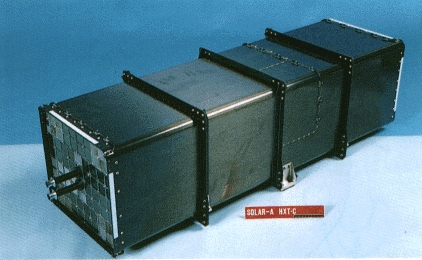

The HXT is a hard X-ray imager of the Fourier-synthesis type,
consisting of 64 modulation subcollimators. Each modulation subcollimator is
equipped with a small NaI(Tl) scintillator and photomultiplier tube, and
measures a modulated photon count. A set of the 64 photon counts, transmitted
from the satellite to the ground, is converted into an image by an image
synthesis procedure, e.g., MEM, PIXON, and CLEAN. The main
characteristics of HXT are summarized below:
i) Simultaneous imaging in
four energy bands, namely, the L-band (13.9 - 22.7 keV), M1-band (22.7 - 32.7
keV), M2-band (32.7 - 52.7 keV), and H-band (52.7 - 92.8 keV).
ii)
Angular resolution of about 5 arcsec with a wide field of view covering the
whole Sun.
iii) Basic temporal resolution of 0.5 s.
iv) High
sensitivity with an effective area of about 60 cm2.
For more detail, see
Kosugi et al., Solar Phys., 136, 17-36, 1991.
The spectral
response of the HXT instrument is summarized in a table and figures below.
Table 1:
Spectral Response
Figure 1:
Effective Filter Characteristics
Figure 2:
Energy Resolution
Figure 3:
Probability of Photon Detection
Figure 4:
Contribution of Incident Photons/keV
Figure 5:
Count Ratio vs Incident Photon Spectrum (Power-Law Spectrum)
Figure 6:
Count Ratio vs Incident Photon Spectrum (Thermal Spectrum)
Go back to the Yohkoh/HXT top page